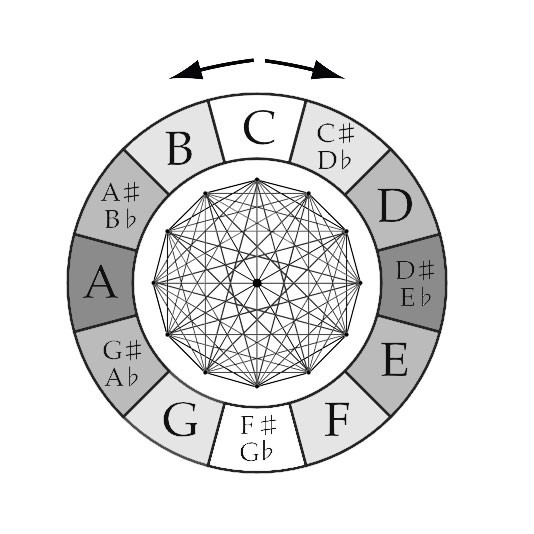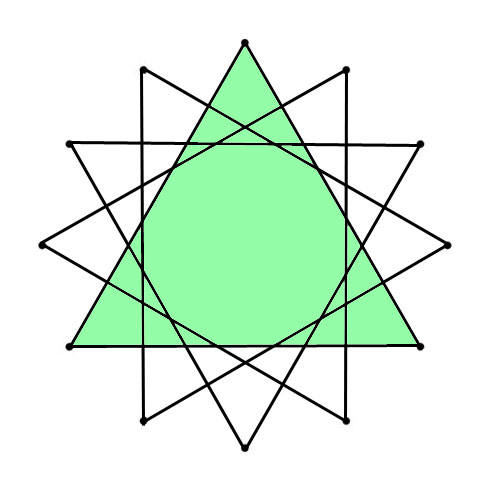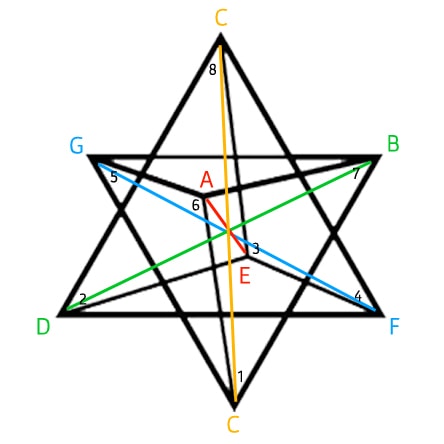MUSIC & GEOMETRY – PART 3 – RHYTHM
GEOMETRY OF RHYTHM
So far in this article we have looked at the geometric relationships between tone (pitch) and geometric shapes (polygons and polygrams). Music though is more then tones alone. An important aspect of music is rhythm and just as with tones, polygons can be used to visualize rhythm.
How does this work?

Well a circle could be divided in any kind of time signatures. You could divide a circle into 4 (standard ‘4/4 time’) or into 3 (‘3/4 time’ – Waltz), into 5 (or ‘5/4 time’ – best known from Dave Brubeck’s “Take Five“), into 7 (‘7/8 time’ – Balkan rhythm), or what ever division you wish to use.
Above you see a division of a circle into 32 parts (4-8-16-32). This can be used for ‘4/4 time’ musical pieces.

You could draw various standard geometric shapes like for example squares, triangles, lines, hexagons, hexagrams, et cetera.
That though will “limit” the rhythmic options you have. Small adjustments in standard shapes could turn a “static” groove into something more irregular or a groove that swings or shuffles …

STANDARD ‘4/4 TIME’ MEASURE – EXAMPLE 1:
In this example on the left you see 3 geometric shapes:1 5-sided uneven polygon, 1 dodecagon and 1 line.
The blue uneven 5-sided polygon visualized the kick drum, the yellow dodecagon visualizes the closed hi-hat and the red line visualizes the snare on the 2 and 4.

STANDARD ‘4/4 TIME’ MEASURE – EXAMPLE 2:
In the example on the left you see 4 geometric shapes:1 line, 1 blue square, 1 green square and 1 polygon with 12 uneven sides.
The blue square visualizes the kick drum in a so called “Four on the Floor” pattern (common for Disco and House music), the green square visualizes the open hi-hat, the yellow uneven-sided polygon visualized the closed hi-hat and the red line visualizes the snare on the 2 and 4.
These were just two very simple examples, but you could make these patterns as complicated as you wish.
XRONOMORPH
The absolute coolest free software you can use for turning geometric shapes into rhythm is called “XronoMorph”.
“XronoMorph is a free OS X and Windows app for creating multilayered rhythmic and melodic loops (hockets). Each rhythmic layer is visualized as a polygon inscribed in a circle, and each polygon can be constructed according to two different mathematical principles: perfect balance and well-formedness (aka MOS). These principles generalize polyrhythms, additive, and Euclidean rhythms. Furthermore, rhythms can be smoothly morphed between, and irrational rhythms with no regular pulse can also be easily constructed.
Each polygon can play an independent sound, and XronoMorph comes with a useful selection of samples to play the rhythms. Alternatively, you can load your own VST or AU plugins, or send MIDI to an external software or hardware synth. The rhythmic loops can be saved as presets within XronoMorph; they can also be saved as Scala scale tuning files, which means XronoMorph can be used as a tool for designing well-formed (MOS) and perfectly balanced microtonal scales.”
Watch the following videos to get a better idea about what you can do with this amazing software:
You can download XronoMorph for free from: www.dynamictonality.com






